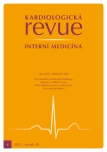A modern view of electric cardioversion of atrial fibrillation
Authors:
J. Přeček; R. Stříbrný; J. Látal; F. Kováčik; M. Hutyra
Authors‘ workplace:
I. interní klinika – kardiologická LF UP a FN Olomouc
Published in:
Kardiol Rev Int Med 2017, 19(4): 243-246
Overview
This article provides an overview of the practical issues of electric cardioversion of atrial fibrillation. Direct current cardioversion is an effective method of converting atrial fibrillation to sinus rhythm. The basic precondition for a safe cardioversion is an effective anticoagulation, or exclusion of intra-cardiac thrombosis by transoesophageal echocardiography, except for patients with clearly documented duration of atrial fibrillation lasting less than 48 hours. The article outlines some aspects of thromboembolism associated with cardioversion and anticoagulation preparation, with an emphasis on direct oral anticoagulants.
Key words:
cardioversion – atrial fibrillation – thromboembolism – anticoagulation – direct oral anticoagulants
Sources
1. Haim M, Hoshen M, Reges O et al. Prospective national study of the prevalence, incidence, management and outcome of a large contemporary cohort of patients with incident non-valvular atrial fibrillation. J Am Heart Assoc 2015; 4(1): e001486. doi: 10.1161/ JAHA.114.001486.
2. Lloyd-Jones DM, Wang TJ, Leip EP et al. Lifetime risk for development of atrial fibrillation: The Framingham Heart Study. Circulation 2004; 110(9): 1042– 1046. doi: 10.1161/ 01.CIR.0000140263.20897.42.
3. Ball J, Carrington MJ, McMurray JJV et al. Atrial fibrillation: profile and burden of an evolving epidemic in the 21st century. Int J Cardiol 2013; 167(5): 1807– 1824. doi: 10.1016/ j.ijcard.2012.12.093.
4. Zoni-Berisso M, Lercari F, Carazza et al. Epidemiology of atrial fibrillation: European perspective. Clin Epidemiol 2014; 6: 213– 220. doi: 10.2147/ CLEP.S47385.
5. Kirchhof P, Benussi S, Kotecha D et al. 2016 ESC Guidelines for the management of atrial fibrillation developed in collaboration with EACTS. Eur Heart J 2016; 37(38): 2893– 2962. doi: 10.1093/ eurheartj/ ehw210.
6. Kato T, Yamashita T, Sagara K et al. Progressive nature of paroxysmal atrial fibrillation. Observations from a 14-year follow-up study. Circ J 2004; 68(6): 568– 572.
7. Airaksinen KJ. Cardioversion of atrial fibrillation and oral anticoagulation. J Atr Fibrillation 2015; 8(3): 1260. doi: 10.4022/ jafib.1260.
8. Hansen ML, Jepsen RM, Olesen JB et al. Thromboembolic risk in 16 274 atrial fibrillation patients undergoing direct current cardioversion with and without oral anticoagulant therapy. Europace 2015; 17(1): 18– 23. doi: 10.1093/ europace/ euu189.
9. Khan IA. Atrial stunning: basics and clinical considerations. Int J Cardiol 2003; 92(2– 3): 113– 128.
10. Nagarakanti R, Ezekowitz MD, Oldgren J et al. Dabigatran versus warfarin in patients with atrial fibrillation: an analysis of patients undergoing cardioversion. Circulation 2011; 123(2): 131– 136. doi: 10.1161/ CIRCULATIONAHA.110.977546.
11. Flaker G, Lopes RD, Al-Khatib SM et al. Efficacy and safety of apixaban in patients after cardioversion for atrial fibrillation: insights from the ARISTOTLE Trial (Apixaban for Reduction in Stroke and Other Thromboembolic Events in Atrial Fibrillation). J Am Coll Cardiol 2014; 63(11): 1082– 1087. doi: 10.1016/ j.jacc.2013.09.062.
12. Piccini JP, Stevens SR, Lokhnygina Y et al. Outcomes after cardioversion and atrial fibrillation ablation in patients treated with rivaroxaban and warfarin in the ROCKET AF trial. J Am Coll Cardiol 2013; 61(19): 1998– 2006. doi: 10.1016/ j.jacc.2013.02.025.
13. Plitt A, Ezekowitz MD, De Caterina R et al. Cardioversion of atrial fibrillation in ENGAGE AF-TIMI 48. Clin Cardiol 2016; 39(6): 345– 346. doi: 10.1002/ clc.22537.
14. Cappato R, Ezekowitz MD, Klein AL et al. Rivaroxaban vs. vitamin K antagonists for cardioversion in atrial fibrillation. Eur Heart J 2014; 35(47): 3346– 3355. doi: 10.1093/ eurheartj/ ehu367.
15. Goette A, Merino JL, Ezekowitz MD et al. Edoxaban versus enoxaparin-warfarin in patients undergoing cardioversion of atrial fibrillation (ENSURE-AF): a randomised, open-label, phase 3b trial. Lancet 2016; 388(10055): 1995– 2003. doi: 10.1016/ S0140-6736(16)31474-X.
16. Ezekowitz M. Apixaban vs heparin/ vitamin K antagonist in anticoagulation-naive patients with atrial fibrillation scheduled for cardioversion: The EMANATE Trial. In: ESC 2017 Hot Line Presentation. Available at: congress365.escardio.org 2017.
17. Klein AL, Grimm RA, Black IW et al. Cardioversion guided by transesophageal echocardiography: the ACUTE pilot study. A randomized, controlled trial. Assessment of Cardioversion Using Transesophageal Echocardiography. Ann Intern Med 1997; 126(3): 200– 209.
18. Boodhoo L, Bordoli G, Mitchell AR et al. The safety and effectiveness of a nurse led cardioversion service under sedation. Heart 2004; 90(12): 1443– 1446. doi: 10.1136/ hrt.2004.034900.
19. Shelton RJ, Allinson A, Johnson T et al. Four years experience of a nurse-led elective cardioversion service within a district general hospital setting. Europace 2006; 8(1): 81– 85. doi: 10.1093/ europace/ euj009.
20. Pisters R, Nieuwlaat R, Prins MH et al. Clinical correlates of immediate success and outcome at 1-year follow-up of real-world cardioversion of atrial fibrillation: the Euro Heart Survey. Europace 2012; 14(5): 666– 674. doi: 10.1093/ europace/ eur406.
21. Crijns HJ, Weijs B, Fairley AM et al. Contemporary real life cardioversion of atrial fibrillation: Results from the multinational RHYTHM-AF study. Int J Cardiol 2014; 172(3): 588– 594. doi: 10.1016/ j.ijcard.2014.01.099.
Labels
Paediatric cardiology Internal medicine Cardiac surgery CardiologyArticle was published in
Cardiology Review

2017 Issue 4
Most read in this issue
- Myocardial ischaemia and infarction in intraventricular conduction malfunctions on ECG
- Current fixed antihypertensive two-drug combinations in Slovakia
- Modern pharmacologic treatment of type 2 diabetes mellitus
- Acute renal failure
